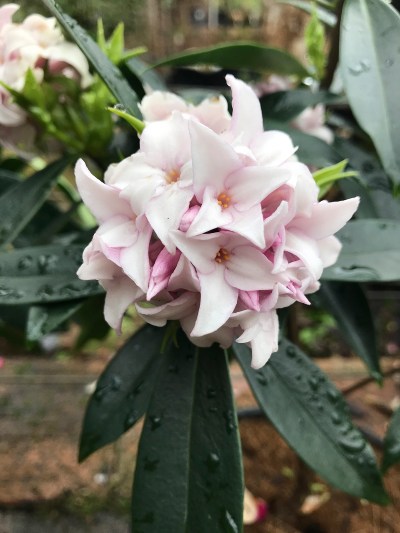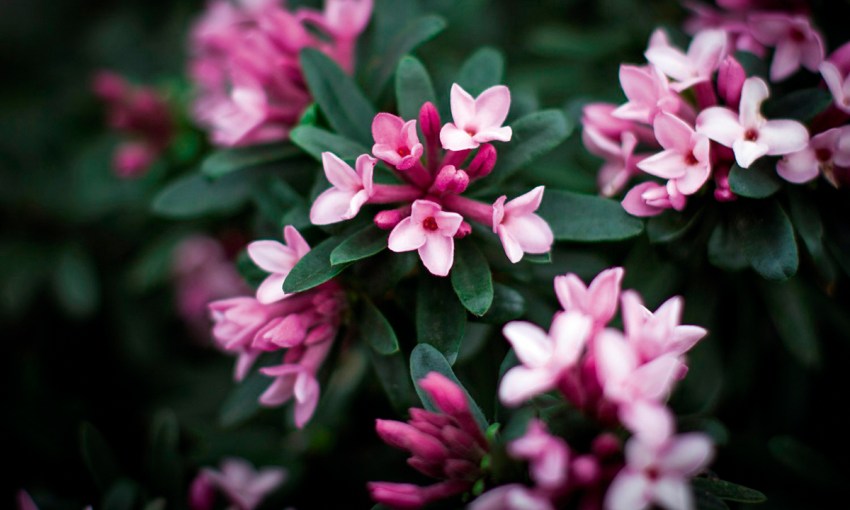The scent of a flower can transport you back to distant memories. For Michael Keelan, that flower is daphne.
In the garden: Darling Daphne

The beautiful, soft, fragrant perfume of daphne transports me straight back to my childhood, as this was my mother Olga’s favourite flower. In the late winter or early springtime when the scented pink and white flowers appeared on the shrub in her garden, she would pick them and bring them indoors and the sweet, spicy perfume would fill the room. Such treasured memories!
In Greek mythology, it’s believed that Daphne was a beautiful nymph who caught the eye of Apollo and legend says that Eros fired two arrows; a gold one that struck Apollo and made him fall in love with Daphne, and a lead arrow that made Daphne hate Apollo! Such a tragic tale behind this gorgeous plant.
There are now more than 50 different species of daphne throughout the world, with some being evergreen and others deciduous. Most plants are medium-sized, neat shrubs, although some types may have a more spreading habit than others. Most will grow well in an area of dappled shade.
The odora species produces soft pink and white flowers, or sometimes pure white, cream or even yellow blooms. They flower in late winter right through to the end of the spring and it’s important to note – contrary to what many people believe – they don’t like wet feet. After watering your daphne bush, it’s important to let the plant dry right out before re-watering again. New varieties of daphne have recently come onto the market, such as “Star White”, a stunning lemon-scented variety with white flowers that is now available at Newman’s Nursery, and “Perfume Princess”, which has white flowers and is the longest flowering of all varieties. Other types include Daphne mezereum, D. cneorum or the hybrid D. burkwoodii.
Daphne grows well in large pots or containers if the drainage is good and the pH level of the soil is between 5.5 and 6.5, as they are acid-loving plants. You can lower the pH level of your soil by adding granular sulphur, compost or sphagnum peat moss. The roots of the daphne bush must be kept cool, so if planted in a container ensure it isn’t black (terracotta is perfect) and that the plant is watered more regularly than specimens planted in the garden.
If a daphne bush is planted in the right position, such as an east-facing spot, it will grow and flower for decades with little or no special care. If the leaves appear limp after flowering, it may be that the bush has been over-watered and if the leaves appear to be a light green, then it may need a feed of iron chelate and a spray of a seaweed-based foliage fertiliser. Daphne has been known to get scale on or under the leaves and if this is detected, use an eco-oil spray according to the directions of the pack.
Daphne rarely survives heavy frosts, but if it is sheltered by other shrubs it can be grown in cool regions. It is sometimes bothered by aphids or soft-bodied sap-sucking insects that can weaken the plant. To control this, spray with an insecticidal soap or a strong jet spray of water from a hose.
When transplanting a daphne bush, be very careful not to damage the roots. Mulch is important around the bush after planting to keep the roots cool and when it finishes flowering in late spring, fertilise with a specifically formulated daphne fertiliser, or one that you would feed camellias with, and lightly prune it at the same time.
Plant a daphne bush in your garden or a container and you’ll be rewarded with the floral beauty and stunning perfume that will permeate right throughout the garden when the bush is in flower. It’s such a pleasure to have indoors as well, and it will last for quite a while as a cut flower.
This story first appeared in the Winter 2019 issue of SALIFE Gardens & Outdoor Living magazine.



